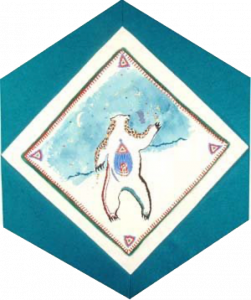Eastern Cree

The Block
Cree artist and print-maker, Virginia Pésémapéo Bordeleau, drew on her peoples’ spiritual relationship with the land and animals of the North for inspiration when creating the East Cree block. She has created her tribute to L’ours chasseur des étoiles (“The Star-chasing Bear”) on white-tanned moose-hide. The backdrop is a hand-painted, navy sky beaded with planets, moon and stars. They are being liberally tossed into the heavens by embroidered bear from the stores upon his shoulders. In traditional Cree mythology, the bear united with the first human woman sent down from the skies, and henceforth became known as “grandfather.”
Cultural Profile
The Cree’s traditional territory borders onto eastern James Bay and southeastern Hudson Bay, stretching westward to the plains. This area, the Cree call Iiyiyuuschii (land of the people), is approximately two-thirds the size of France. The people speak five dialects, all related to the Algonquian linguistic family. They call themselves Ayisiniwok (true men) or Iynu (the people) and are Canada’s largest First Nations group. The name Cree is the shortened version of “Kristenaux”, given to them by French fur traders.
The East Cree have also been known as the East-Main Cree, James Bay Cree, and Moose Cree. The various bands often view their own identity as quite distinct from each other. Still, they share many of the same cultural values and social mores. Hunting is a major part of their traditional practices, filled with meaning, beliefs and rituals. It is believed that as much skill as the hunter may have, it is the animal who gives itself to be killed. The process is a relationship between hunter and hunted, and success a mutual effort on behalf of both man and environment.
Once small nomadic groups, the Cree first came into contact with Europeans in 1610, during the explorations of Henry Hudson. Traders sought the highly prized fur pelts the Cree collected, providing a new way for them to earn a living. In modern times, the incursion of mining, forestry and hydroelectric projects (such as the James Bay project) has drastically affected their way of life and resulted in the forced relocation of entire villages. Yet to this day, the territory provides many Cree with their traditional livelihood from wild game such as moose, caribou, geese, and fish.
Sponsor: Forrest and Jane Rietze
